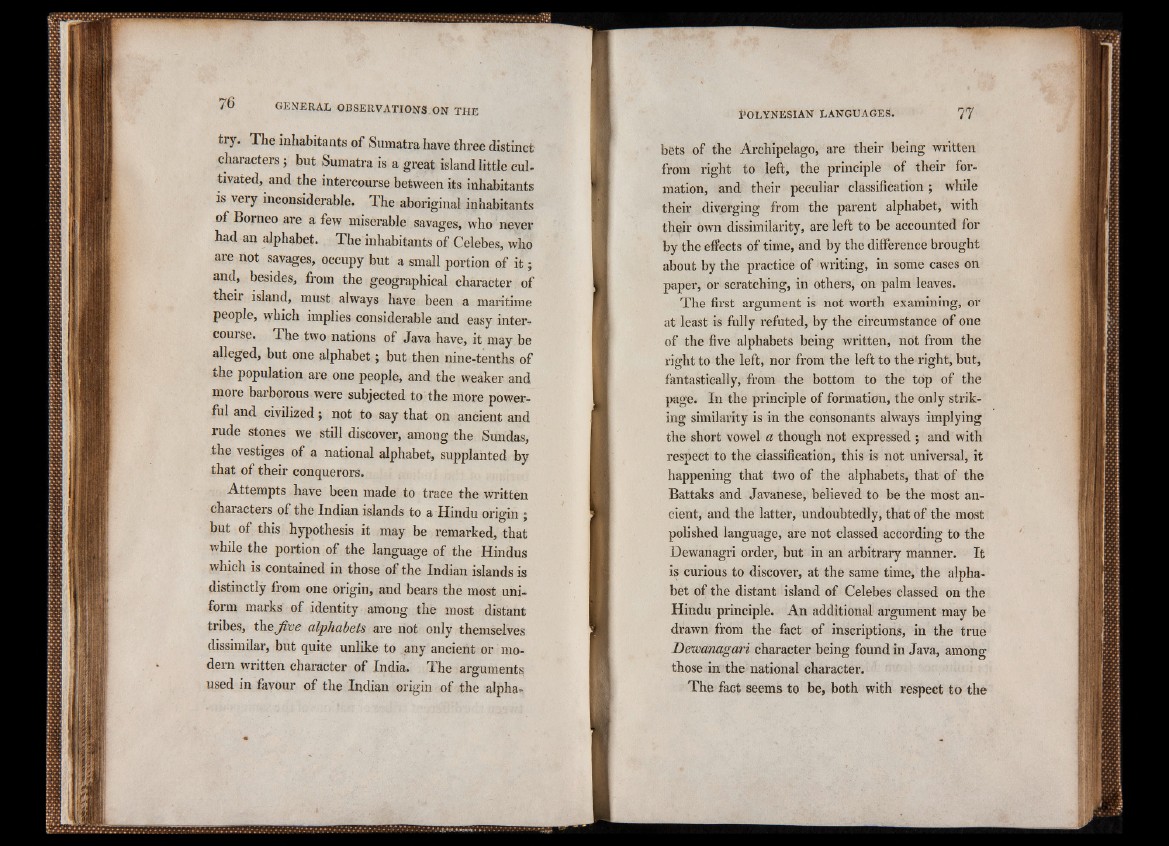
try. The inhabitants of Sumatra have three distinct
characters; but Sumatra is a great island little cultivated,
and the intercourse between its inhabitants
is very inconsiderable. The aboriginal inhabitants
of Borneo are a few miserable savages, who never
had an alphabet. The inhabitants of Celebes, who
are not savages, occupy but a small portion of i t ;
and, besides, from the geographical character of
their island, must always have been a maritime
people, which implies considerable and easy inter-
course. The two nations of Java have, it may be
alleged, but one alphabet; but then nine-tenths of
the population are one people, and the weaker and
more barborous were subjected to the more powerful
and civilized; not to say that on ancient and
rude stones we still discover, among the Sundas,
the vestiges of a national alphabet, supplanted by
that of their conquerors.
Attempts have been made to trace the written
characters of the Indian islands to a Hindu origin j
but of this hypothesis it may be remarked, that
while the portion of the language of the Hindus
which is contained in those of the Indian islands is
distinctly from one origin, and bears the most uniform
marks of identity among the most distant
tribes, thejvoe alphabets are not only themselves
dissimilar, but quite unlike to any ancient or modern
written character of India. The arguments!
used in favour of the Indian origin of the alphabets
of the Archipelago, are their being written
from right to left, the principle of their formation,
and their peculiar classification ; while
their diverging from the parent alphabet, with
their own dissimilarity, are left to be accounted for
by the effects of time, and by the difference brought
about by the practice of writing, in some cases on
paper, or scratching, in others, on palm leaves.
The first argument is not worth examining, or
at least is fully refuted, by the circumstance of one
of the five alphabets being written, not from the
right to the left, nor from the left to the right, but,
fantastically, from the bottom to the top of the
page. In the principle of formation, the only striking
similarity is in the consonants always implying
the short vowel a though not expressed ; and with
respect to the classification, this is not universal, it
happening that two of the alphabets, that of the
Battaks and Javanese, believed to be the most ancient,
and the latter, undoubtedly, that of the most
polished language, are not classed according to the
Dewanagri order, but in an arbitrary manner. It
is curious to discover, at the same time, the alphabet
of the distant island of Celebes classed on the
Hindu principle. An additional argument may be
drawn from the fact of inscriptions, in the true
Dewanagari character being found in Java, among
those in the national character.
The fact seems to be, both with respect to the